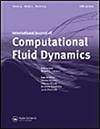Numerical Simulations and Design Optimization of Compressor Cascade Flow Using One Equation and Wray-Agarwal Turbulence Model
IF 1.3
4区 工程技术
Q4 MECHANICS
International Journal of Computational Fluid Dynamics
Pub Date : 2022-09-14
DOI:10.1080/10618562.2023.2187050
引用次数: 0
Abstract
The unsteady simulations are conducted, and the computed results with WA model are compared with the experimental data in conjunction with the simulation results obtained using traditional models. It is shown that on the mid-span sections of the cascade airfoils the distributions of near-wall static pressure coefficients from each turbulence model agree well with the experimental data. On the lower spanwise sections, the discrepancy between the numerical simulations and experimental data generally increases. Among the three turbulence models, the WA turbulence model shows better agreement with the experimental data in predicting the spanwise total pressure losses downstream of the cascade blade. The WA model is then embedded into the adjoint optimisation loop to test its capability in minimising the flow losses in the compressor cascade passage. The optimisation results show that the total pressure loss coefficient of the optimised compressor cascade is reduced by 18.1% compared to the baseline design.基于单方程和Wray-Agarwal湍流模型的压气机叶栅流动数值模拟及设计优化
进行了非定常数值模拟,并将WA模型的计算结果与实验数据进行了比较,并结合传统模型的仿真结果进行了比较。结果表明,在叶栅翼型跨中截面上,各湍流模型的近壁静压系数分布与实验数据吻合较好。在较低的展向截面上,数值模拟与实验数据的差异普遍增大。在三种湍流模型中,WA湍流模型在预测叶栅下游展向总压损失方面与实验数据吻合较好。然后将WA模型嵌入到伴随优化回路中,以测试其在最小化压缩机叶栅通道中的流动损失方面的能力。优化结果表明,与基准设计相比,优化后的压气机叶栅总压损失系数降低了18.1%。
本文章由计算机程序翻译,如有差异,请以英文原文为准。
求助全文
约1分钟内获得全文
求助全文
来源期刊
CiteScore
2.70
自引率
7.70%
发文量
25
审稿时长
3 months
期刊介绍:
The International Journal of Computational Fluid Dynamics publishes innovative CFD research, both fundamental and applied, with applications in a wide variety of fields.
The Journal emphasizes accurate predictive tools for 3D flow analysis and design, and those promoting a deeper understanding of the physics of 3D fluid motion. Relevant and innovative practical and industrial 3D applications, as well as those of an interdisciplinary nature, are encouraged.

 求助内容:
求助内容: 应助结果提醒方式:
应助结果提醒方式:


